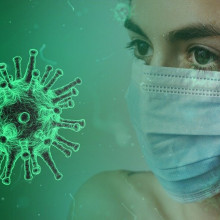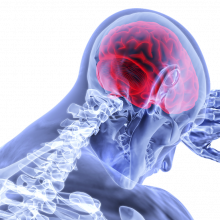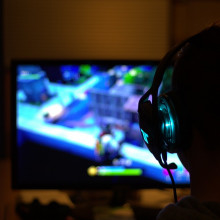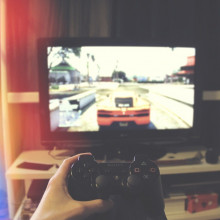Video Games on the Brain
Grab your controllers, we’re diving into the world of videogames, how the music can get into your head, the psychology of games, and how they might have helped during lockdown. Plus in the news, should we be worried about new COVID variants, we find out about a potential origin for migraines, and why you might not want to drink George’s Marvellous Medicine from Roald Dahl’s book!
In this episode

01:00 - A new variant of COVID sweeps through England
A new variant of COVID sweeps through England
Zania Stamataki, University of Birmingham
UK Health Secretary Matt Hancock dropped what sounded like a virological bombshell in Parliament that a new variant of COVID-19 was sweeping through England. The announcement completely broadsided the media; there'd been no prior warning this was coming and no background briefings, so speculation was predictably rife and the story stole the front pages of Tuesday's dailies with alarming headlines about mutant coronaviruses. But was this in fact just a smokescreen to distract attention from the fact that over 10 million people were simultaneously plunged into a more restrictive tier than they had been before, or does this new viral variant really pose a significant threat, and how was it picked up in the first place? Chris Smith spoke to Zania Stamataki, an immunologist based in Birmingham...
Zania - Viruses mutate. They change, as they grow, and it's quite normal for them to turn into different variants of their previous entities as time passes. So this virus came into humans back in December last year, it had a year to change around the world. And it's now quite natural that we are going to see different forms of this virus in different parts of the world.
Chris S - This one that's been picked up and has made headlines being in parts of London, the Southeast of England, what's its significance to the coronavirus outbreak in general?
Zania - So Public Health England is monitoring viruses because we need to understand how they are changing, so that we can monitor our immunity to these viruses as well. This particular variant has been watched, because it has quite a few changes from the original described virus. So not just one mutation, but several mutations combined.
Chris S - How was it picked up in the first place?
Zania - We keep surveillance on these viruses. We are taking isolates from patients from different parts of the country and different parts of the world. And we are very used to this because we used to do it for influenza. And when a virus is starting to look like its proteins that it has on their surface, like you've heard of the spike protein that coats this virus particle, and if it starts to get a little bit different, then we're keeping a look for that to see if our vaccine preparations are going to still be effective against it. And if our immune responses are going to keep up with the virus.
Chris S - And to what extent do you think this is contributing to a bigger outbreak in the South East of England? Because one of the other things that the health secretary said was,, this might be linked to the fact that we're seeing surging case numbers in some places and where we see those surge in case numbers, we see more of these variants, but he did say, we don't know if it's cause or effect.
Zania - Exactly. So we don't know if it's the chicken or the egg. We know that this variant is prevalent in the South of the country, but we don't know if it is in the South of the country, because it is prevalent. It is more likely that the virus emerged in the South of the country. And then the spread was more abundant in that area, that meant that more people are having it. So it's more likely linked to our own practices. We have very highly populated cities in the South of the country. People are taking a lot of public transport. It's more difficult for them to protect themselves, than in less densely populated regions. So if a virus emerges, that is a variant in that region, it's going to spread.
Chris S - What will be the nature of the experiments that institutions like Porton Down will do to test whether or not this change to the virus is giving it the ability to sidestep our immune response.
Zania - Well, first of all, they are going to look at isolating this virus, and they're going to try to get it to infect in the laboratory. And in fact, with coronaviruses, this is very easy. They are delighted to grow in the lab. As I can say from my own personal experience. So they're going to grow it in the lab, but then we're going to expose it to antibodies from the blood of patients that have recovered from the virus from different parts of the country. So if somebody that has recovered from the virus in the West Midlands, that has got antibodies that recognise this virus, then the virus hasn't changed sufficiently. If the virus is not being recognised, then the virus has changed enough to escape our antibody response.
Chris S - And presumably similar sorts of experiments will be done using antibodies made from vaccinated individuals, either humans or animals, to test the possibility that these changes might enable the virus to put itself beyond the reach of the protection conferred by the vaccine. We hope it won't be, but I suppose there's a theoretical possibility it could.
Zania - Exactly. And these experiments are not difficult to do. We are having virologists chase the virus, to look at surveillance of how the virus is changing. And we have immunologists chase the human immune response to see how our antibodies are evolving to keep up with the virus. So it's a game of cat and mouse really,
Chris S - But overall you're more kind of reassured, than alarmed, reassured by the fact that surveillance has picked this up, but not alarmed because this is kind of par for the course with these sorts of viruses.
Zania - It is totally part of the course. I am not alarmed, the virus is expected to change. In fact, this is a known feature of coronaviruses. And in fact, I would like people to be reassured as well, that the technologies that we have to make vaccines now are so advanced, that it is really easy for us to tweak the vaccine preparation, to keep up with new viral variants, as they emerge in the years to come.

07:36 - A potential origin for migraines
A potential origin for migraines
K.C. Brennan, University of Utah
Mice that get migraines have helped scientists in the US to uncover what might be going on in the more than 10 per cent of us who suffer from the condition. What K.C. Brennan at the University of Utah has done is to make a genetic change in his mice, so they mimic the make-up of one group of humans who suffer regular migraines. By watching the brains of these animals, they’ve found that, periodically, surges appear of an excitatory nerve signal called glutamate. This, they speculate, causes overstimulation of the nearby nerve cells, starting the neurological equivalent of a Mexican wave that ripples across the brain. As it does so, it activates pain pathways that cause the ensuing headache. As K.C. Brennan explained to Chris Smith, these new insights should enable the Utah team to unpick how this happens and better ways to control it…
K.C. - We, on the most fundamental level, are trying to understand how migraine works. The approach we took was to use mice, carrying a gene that comes from a family of people who have hereditary migraine. This is a rare form of migraine, but it allows us to place the gene in the mouse, and actually ask very detailed questions that we wouldn't be able to ask with humans directly.
Chris S - But critically you can't ask a mouse if it's got a headache. So how do you know when the mouse is experiencing migraine phenomena?
K.C. - It's a very good question. For migraine with aura, this is migraine that many people will be familiar with, where you have a change in your vision, flashing lights, or sometimes people get numbness or tingling that moves, or some people lose the ability to speak, for migraine, with aura, we know that there's an event in the brain called a spreading depolarisation that underlies the migraine aura. We can look at this spreading depolarisation in the mice, and if they have the spreading depolarisation, there's other work that shows that we can assume that they have the beginnings of a migraine. So it gives us a real purchase on the subject.
Chris S - So when a person is having a migraine, there is some kind of abnormal electrical activity in at least one part of the brain to start with. And you're saying, you then get this spreading wave of changed behaviour that goes across the brain, might take in some other areas, including visual areas, which is why people see these flashing lights and so on, or experience abnormal sensations for awhile. How does that then link to the headache that comes later?
K.C. - People have found that the spreading depolarisation, this spreading wave of excitation that moves across the brain will cause pain sensing nerves to fire. And those pain sensing nerves are what generate the sensation of the headache.
Chris S - So that argues then, if we can get underneath what causes the initial wave of depolarisation, because that's upstream of the headache, we ought be able to knock the migraine on the head.
K.C. - Exactly.
Chris S - What did you actually do with these mice, that then gives us insights into that mechanism, and what might be causing it, and what might be causing it to spread in this way in the first place?
K.C. - So the mice have a little tiny window carved into their skull that allows us to look at their brain cells as they are going about their business. And this was where the surprise came. We saw these, what we call plumes, basically puffs or clouds of something called glutamate. So glutamate is the major excitatory neurotransmitter in the brain. It is used for brain cells, neurons, to communicate. It's absolutely essential, but it's kept within very, very tight bounds under normal circumstances. It's a substance that's absolutely essential for me to be talking to you right now and for you to be hearing me. And it looks like it was not kept in tight bounds in these animals.
Chris S - Putting this together, then. Would you say that a way of thinking about this is that for some reason, in individuals who are prone to migraines, that the normal rigid tight control of their glutamate occasionally gets a bit out of control in one bit of the brain, and they get this geyser goes off. And the big plume of glutamate showers a patch of brain, and the nerves there become more active than they should. And that then triggers the ones next door. And you get this sort of domino effect radiating out from where this started, spreading out that burst of activity across the brain surface. And that's the migraine kicking off. You'll see the aura, then, it's followed later by the pain. And because the brain is a bit more susceptible to not keeping control of its glutamate level, that's why it's easier for that wave of glutamate to spread across the brain in that way in those people.
K.C. - That's a lovely summation. And in being a responsible scientist, I'd have to say that's a lovely hypothesis at this point, but we can actually be as precise as you were in formulating that hypothesis about how migraines start. And that's, I think one of the exciting advances of this work,
Chris S - The problem is that glutamate is an incredibly universal transmitter, nerve transmitters, isn't it, it's an excitatory transmitter throughout the brain. So it's going to be quite tricky to turn it off without causing enormous numbers of side effects. So what do you propose to do, now you understand this a bit better for people who are prone to migraines.
K.C. - It's a very important question. So on the one hand, this does validate certain treatments that we use. We have migraine preventive drugs, for example, that suppress glutamate related excitation. So this validates, those presently used treatments, but like you said, drugs that willy nilly take glutamate levels down, have profound side effects, the best example of that is ketamine or "Special K," what we would really like to do in future is dive deeper into the very basic mechanisms of these plume events, so that we can develop more precision, fine tuned drugs that could prevent the onset of plumes, but preserve normal activity in the brain.

14:39 - Fixing interference in GPS
Fixing interference in GPS
Ramsey Faragher, Focal Point Positioning
Possibly the most important traveller around now is Santa Claus, and to make sure he gets to all those houses on time he needs a really good GPS. Imagine if the GPS told him he was at a nice child’s house, but was actually at they’re naughty neighbour. Well a Cambridge based company, Focal Point Positioning, has teamed up with a European company, u-blox, to help fix a key weakness in the technology, multipath interference. Adam Murphy heard how it works from Focal Point Positioning CEO, Ramsey Faragher...
Ramsey - It's the effect that's caused by lots of echoes of a radio signal, bouncing around inside a city, confusing your GPS chip and making it calculate a wrong position. It's a bit like trying to host a very loud dinner party inside a big cave. It would quickly turn into a noisy confusing cacophony, due to all of those echoes. And GPS is designed for open spaces where there are no signal reflections. This problem of multi-path interference, the problem of signal echoes from buildings has actually been the biggest cause of bad GPS fixes for the last 20 years.
Adam - Now, given all that being true, my phone's GPS is still pretty good. So why is fixing this and making it better, so important?
Ramsey - So it's true that on a good day out in the open, that little smartphone in your pocket can work out where you are to within a few metres. And that is then both a blessing and a curse, because if you become very reliant on that good accuracy outdoors in the middle of nowhere, when you go and try and use that GPS in the middle of downtown New York, or London city centre, or Tokyo surrounded by big, tall reflective buildings, and only then do you discover that it's actually quite inaccurate in those places. It can cause you major problems, your taxi turning up on the wrong side of the street, your food delivery going to the wrong house. In future problems for drone deliveries, getting it all wrong. Autonomous cars, not being able to navigate safely in amongst the tallest nastiest buildings. And that's what we fixed. And it opens up lots of new opportunities for metre level positioning right down there amongst the skyscrapers.
Adam - Well then I suppose the key question to ask you is how does it work? What is your solution?
Ramsey - We went right back to the very lowest level of the physics of the problem, and created the fix right from there. So when the signals bounce around, that means they're coming at you from the wrong directions now, relative to the actual location of the satellites in the sky. And we do always know exactly where those satellites are, but the GPS chip itself has never been able to work that out. It can't calculate the angles that the different signals are coming from. The only way to do that normally has been with a very, very expensive antenna. I'm talking about thousands of pounds for an antenna. It'll never be on a smartphone, but what we figured out, was a way to change the software inside the GPS chip itself so that it can now calculate all of these different angles of arrival, of all of the different signals and unpick them from each other, and separate out the one line of sight signal you want from all of the echoes you don't want. And we can make the chip ignore all of those echoes and voila, no more multipath interference.
Adam - So it's like when you got a tangled mess of headphones in your pocket, the phone is now doing software to unpick that, to get your headphones back to what they should be.
Ramsey - Yeah, exactly.
Adam - And is this something that can be easily implemented everywhere, in every phone, or are there some really key focused applications?
Ramsey - So it is just a matter of upgrading the software inside the GPS chip. And that then means we can solve multipath for any device that uses radio signals to navigate just like GPS. So any application for a moving GPS receiver, we can help, but my company itself cannot change the software on the GPS chip completely on our own. The change has to be made by the manufacturer, that software change only takes a few months to do. In reality, getting a billion-dollar GPS chip set company to hand over the keys to their pride and joy, to my startup, doesn't happen overnight. And so we generally have to do quite a lot of trialing and verification with those companies to prove that our tech does what we say it can, but we've made great progress with major GPS chip set companies. u-blox being the first deal that we can publicly announce, and there'll be many more like it in the future. And I can also announce here on the Naked Scientists for the very first time, that Focal Point Positioning has also been working very closely with Santa for many, many years now. And we always help to ensure that he never has any navigational problems on his big night out.
Adam - It's very important to know Santa will be safe, what's next then, what's the future of this kind of technology?
Ramsey - Well, the exciting thing is that we can help bring one metre positioning to your smartphone in cities right now, with the current generation of GPS chips. But next on our roadmap is trying to get that right down to 10 centimetres. Maybe even down to two centimetres, that's the sort of thing we're aiming for in the future. And then that will open up a whole host of new ways that people can make use of GPS for all sorts of exciting new purposes.

20:05 - Toxicology of George's Marvellous Medicine
Toxicology of George's Marvellous Medicine
Graham Johnson, University of Nottingham
In Roald Dahl’s famous book “George’s Marvellous Medicine”, a young boy called George decides to make his grandma less cranky and horrible by replacing her usual medicine with his own invention. His improvised concoction uses items from all over his house, from shampoo and toothpaste, to floor polish, engine oil and antifreeze. When his gran drinks it, she grows as tall as the house, a result that real-world paediatric doctors Graham Johnson and Patrick Davies decided needed checking. And so, helped by their own kids, they’ve analysed George’s recipe, as Graham explained to Phil Sansom…
Graham - He wasn't quite as scientific as we would have liked him to have been. He didn't write it down. And that means he comes a bit unstuck when grandma becomes really invigorated and grows enormous. And his father is really excited by that because he thinks, "Oh, wow, we can make a lot of money out of this." And because he hasn't been systematic and noted everything down, medicines two, three, and four have very, very different effects.
Phil - Right. Obviously we frown on that kind of process, not scientific. So what's the right way to do it? What did you do?
Graham - We employed five very junior researchers.
Phil - How junior?
Graham - Well, the youngest was seven and didn't have his school pen license at the time. They worked in three different groups, and they went through the book, writing down every single ingredient. Then we compared those groups. So there's three independent groups that they were in. We made sure that all their results were the same, which they were, and went to the national poisons information service website called TOXBASE, and looked up all the different ingredients, and what possible toxic effects that they would give.
Phil - All sounds very rigorous, all sounds very above board.
Graham - I'd like to think so.
Phil - What did you find?
Graham - Uh.
Phil - You're making noises that make it sound not good!
Graham - There was quite a lot to find. So, basically grandma would not have been very well at all. Actually some of Roald Dahl's descriptions were really accurate. So she talks about how her stomach's on fire. There are lots of ingredients that might cause indigestion, or nausea, and vomiting, and gastric ulcers, and things, sheep dip in there, and shoe polish. She starts to swell and there were a few ingredients in there that might cause some foaming in particular in there, in that things like the shampoo. Then there's, she has this sudden sharp twist and jerk and flips herself out of the chair. There were several ingredients that would cause convulsions. But from there, she starts to grow, and she becomes invigorated, and she bursts through the roof of the house. That's not really what would have happened, unfortunately. There are several ingredients in there that would make her very sleepy. In addition to the convulsions, she might have stopped breathing, developed kidney failure. There were several ingredients that would cause vomiting. And then these erosions in her oesophagus, and maybe through to her aorta and all sorts, you'd have been in a right mess.
Phil - This is not looking good for grandma.
Graham - Not at all.
Phil - What do you predict would have happened to her?
Graham - It is highly unlikely that she would have survived such a toxicological insult.
Phil - It's interesting. Because it's very different from the results reported in the book.
Graham - It is.
Phil - I'm just wondering maybe, are there some interactions maybe that you don't have in your database, something like that, that make a person become giant?
Graham - Yeah, that's possible. I mean, we weren't able to reproduce the singing and the chanting, and obviously we are just extrapolating from known results, and we haven't recreated making this medicine.
Phil - It's not really a way around that is there?
Graham - Not so much. No.
Phil - If I want to tinker with the recipe myself, what do I have to do? Do I have to go through the rigmarole of what you did, and go through the database or do I have to make one or what?
Graham - Well, we've tried to make this easier for you, or the BMJ have. So if you go to the bmj.com and look for George's Marvellous Medicine and our paper is there, they have made a simulator so that you can mix all the different ingredients from around the house, and see how poorly that they would make you. And there are some little Easter eggs in there as well, that are not on the achievements board. So please go and have a look at that and have a play.
Phil - If I unlock any of those Easter eggs, do I become an honorary marvellous medical doctor?
Graham - Absolutely. I would be delighted if you tweeted both me and Patrick Davies, if you managed to unlock one of the three Easter eggs, you'll know that you've found one because I'll give you a little clue, a chicken appears, a certain chicken. So please tweet me if you managed to find out one of those.

24:47 - Telling the future with apples
Telling the future with apples
Olga Löblová, University of Cambridge
With a new year on the horizon, Adam Murphy's been finding out about Czech tradition that looks towards the year ahead, with the help of Olga Löblová, from the University of Cambridge...
Adam - There’s lots of weird ways to tell the future, in Ancient Rome, there were augurs, people who would look at the formation of birds to give omens. There are oneiromancers, people who look to dreams for clues, or omphalomancy, which claims to tell you how many children a woman will have looking at her navel.
In the Czech Republic, they’ve a simpler, and perhaps more fun Christmas tradition about telling the future, with some apples, as Olga Löblová tells us
Olga - In Czechia we have a lot of traditional activities that often aim at predicting what will happen in the year ahead. For example, you take an apple and cut it in half on Christmas Eve, but not along the vertical axis, like you’d normally do, but horizontally, and take a look at the core.
Adam - We’ve a similar thing in Ireland at Hallowe’en. If you find the coin in the bread loaf, the bairn brack, you’ll have a prosperous year….provided you don’t choke. So what do the apples mean.
Olga - If you see a star, it means the coming year will be full of health. If you see a worm or the apple is rotten inside, there’ll be illness and disease. And if you see a cross, it means someone will die.
Adam - Oh dear. Let’s hope no crosses then. Scientifically, there’s not a lot to the idea of divination. We can predict some things, if you drop that apple, it will fall. And it could hit some unsuspecting physicist on the head for example, but in general, it falls flat. You just have to watch a weather forecast to see how unreliable the future can be.
There was once an idea called Laplace’s Demon, that if you had a magical demon who knew where everything was, and where it was going, it could run the clock forward and predict everything. But then Quantum Mechanics, which is based on probability.
So even the nicest Christmas traditions can’t predict the future. But maybe that’s okay. We can take the future into our own hands and make this Christmas merry, and make the next year, better than this one.

29:07 - Generating music in video games
Generating music in video games
Paul Weir, EarCom
Adam Murphy's been taking a look at how important what you hear can be when enjoying a video game, and how hard that can be to make as the game gets bigger and bigger, as he found out when he spoke to Paul Weir from EarCom, and audio Chief for the game No Man's Sky...
Adam - Games aren't just pushing buttons. The music in a game can be vital for setting a mood. You know you’re walking into a boss fight when the music gets uncomfortably intense. The problem though, is at any given time the player could be doing anything, walking in the right direction, enjoying the scenery, leaving their character motionless while they get a cup of tea, so how do you get the music right? I spoke to Paul Weir, video game music composer from EarCom, and Audio Chief for the game No Man’s Sky about how you make music for a video game.
Paul - I guess, as a composer, you know, you're trying to find those key moments, and the overall tone, you have the difference with film is all those moments in film are engineered for you and laid out for you. You can't really often do that in games. So you're looking for just those key moments where you can inject a certain feel, certain type of emotion, and often they may be very specific. It may be like in No Man's Sky. First time you leave a planet after building your spaceship. So it's just allowing the game to breathe and injecting those moments with a certain key emotion.
Adam - No Man’s Sky is a procedurally generated game, that means as you rocket around space in your ship, the game builds the galaxy as you go using random number generators, and some very sophisticated algorithms. That means no two players will see the same planets, or have exactly the same experience. So how do you match music for a game that everyone experiences differently, and you don’t play easy listening jazz during a big fight? Well, you use something called generative music.
Paul - Generative music. I mean it to be that you use rules, so probabilistic rules that are imposed on small, granular elements of music. So it may be a simple phase, maybe a bar loop, or like a base phase. Deconstructing the music into its components and then reconstructing it live based on certain rules that you've created. It may be "play a melody, every X number of seconds from a pool of say, 200 melodies." So it really requires you as a composer, to work in a different way, to work in a much more kind of modular, nonlinear way. It's like a recipe. You're creating all the components putting in all the ingredients. But instead of baking it before the game, you're letting the game create it for you. And then often drawing information from the game, in order to control what plays, how it plays, what the combinations are, when the changes happen. And that can be very powerful because you're reacting to what the player's doing, or what the game environment is doing. So it feels much more reactive to a player.
Adam - What gives it an impact though? How do you create emotion ahead of time with just the pieces of music?
Paul - It's hard to create those engineered emotional moments. So what you need to do is create the opportunity for those moments to happen without necessarily hard-wiring them. In No Man's Sky you may happen to be on a planet that generates beautiful sunsets, and you may happen to be there at the right time on a mountain to see that sunset, and to you, that feels very personal. It somehow connects with you because you're the only person to have ever seen that sunset on that planet. And the music is the same, maybe 80% of the time, it just exists and it's supporting the game. It's fine. It's not doing anything particularly spectacular, but there are those few moments where everything comes together, and it's random, but we've allowed those random opportunities to happen. And when they do happen, they're very powerful.
Adam - And if everyone plays for long enough, they'll run into one of those moments.
Paul - So that's the beauty of a procedural game. Everyone does have those moments and it has those stories to tell, and their stories are very individual. And that's, I think that's one of the really powerful things about procedural games. You know, everyone's experience is slightly different. Everyone tends to be very proud of those moments that they find. They'll game capture them, whereas a game which is much more linear, you know, everyone's experience is essentially the same. It doesn't mean it's any less fun, but it's a different kind of personal experience.

33:54 - Exploring the Uncanny Valley
Exploring the Uncanny Valley
Angela Tinwell, University of Bolton
When we play a video game, what we see matters, and not always in the way we expect. For example have you ever seen a character’s face and felt uneasy? Sometimes things are wrong in ways that we can’t quite put our finger on. That might work against a game, but in special cases, it can work for it. Angela Tinwell from the University of Bolton looks at one facet of this, called the “Uncanny Valley” and she spoke to Chris Berrow…
Angela - Well, the idea of the Uncanny was first introduced by Ernst Jentsch in the early 20th century. And he described the Uncanny as an eerie sensation when you can't distinguish between what's alive or dead, what may be real or unreal. For example, of a tall waxwork doll, a crafted child's toy, or automator, and building on this, Freud actually described the Uncanny as an eerie sensation, or what might be unfamiliar when we see an object and it actually reminds us of our own death, or what might be repressed in ourselves or in others. Now, Mori, a Japanese roboticist in the late 1970s, he took this idea forward, because he observed with regards to robot design, engineers were including mechanical robots in the workplace, but people were developing more and more life-like androids, with synthetic skin, hair and flesh over the mechanical parts. But rather than having an increased affinity or likeability towards these new android designs, people actually suddenly took an instant dislike or repulsion towards them. And he actually coined this theory the Uncanny Valley, because we actually have a linear ascent with regards increased human likeness and perceived familiarity or likeability, for example, with a robot toy that emotes like a human that may have eyes, and a smile, and torso, and limbs. But as soon as we approach android designs, pushing the boundaries of true, of near human likeness, we take this sudden aversion towards them. And Mori placed things such as corpses, zombies, prosthetic hands, in this nadir of this Uncanny Valley with a human safely on the other side
Chris B - So interesting isn't it. And you've already explained my fear of dolls, and wooden toys, and things like that. But I want to ask you, so you mentioned video games and zombies is something that's so hugely included in video games nowadays. And I suppose, kind of scary horror games. What is it about the face specifically that people start to feel uneasy about? I suppose is it the eyes, mostly, the emotion comes from the eyes?
Angela - It actually comes down to, the best way to describe it, is Frankenstein's Monster, where we perceive a lack of movement in the brows, the forehead, and distinctly around the eyes, and the upper facial region. And that's important because we really do read a lot of non-verbal communication from another person's face, because the mouth might be involved in speech. And we rely on the upper face to give us an idea of what someone's feeling, thinking, and how they may respond to occurrences that are happening around them. And without this nonverbal feedback in the upper face, we might perceive that the lights are on, but no one's actually home in that character, but we can't perceive, or predict, what they're going to be doing, and when. And that makes us really uncomfortable.
Chris B - Well, I want to come on to how that might actually be useful for certain types of video games, but just before that, I've been playing on one of the biggest releases today, Cyberpunk 2077, one of the biggest releases of the year, the Last of us Part 2 as well, they are games which have very good facial capture, and motion capture. Is that one way that these huge companies are actually trying to tackle this problem?
Angela - Absolutely. You've got more and more sophisticated, high density, facial motion capture techniques that are being introduced to the game's animation, particularly with pre-rendered video footage that's played in games. And even in real time footage, the facial expression and emotive qualities of characters is improving. And you mentioned Cyberpunk 2077. That has received a lot of criticism in the last few days, but I would say that there are few small triumphs in the actual game. In that, for example, Claire, a character who plays a bartender, the upper facial expression, actually matches the emotive tones of her speech. And you can see that there's a lot of theory and conceptual thinking going on, by the way that her brow creases, and you have these emblems in her brows, moving up and down, that matches the tonation of her speech. The lip synchronisation is very good for that character, and she really draws you in and is very engaging. So I would say that, Claire the bartender is particularly successful with regards to facial expression in that game.
Chris B - The way that these motion captures and faces and the fact that sometimes they can look a bit unusual is actually something that can feed in very well to horror games. One that my wife has been enjoying loads recently is something called Little Nightmares, where you're a little kid running around essentially, and there's these evil creatures. And as you look at their faces, they sort of don't move, and they look almost like jagged, and the mouth will move, but the eyes will stay stationary. I imagine that actually in this instance, game designers will be tapping into this Uncanny Valley and using it to their advantage?
Angela - Absolutely. If a face is inanimate, or it has an aberrant facial expression, we may be reminded of death, which of course gives us quite uncomfortable feelings. If a game designer wanted to exaggerate the uncanny in a zombie type character, then based on the empirical experiments that I've done, I would definitely say reduce movement in the upper face, including the eyes, the eyebrows and the forehead, so that the character may have a Botox like effect, a grey or dull colour skin tone also would increase how antipathetic the character may seem. And also with regards to lip movement and speech, a distinct lack of synchrony between lip movement and speech does exaggerate the Uncanny, particularly if the speech is played before we see lip movement.

40:59 - Video games are challenging how we think
Video games are challenging how we think
Matthew Whitby, University of York
There’s a lot more a game can do to get into your head than just playing with your senses, the right game can change your whole worldview as Adam Murphy found out from Matthew Whitby at the University of York...
Adam - Games are often challenging, but not in the way you might think. Sure, they can be hard, as anyone who's almost broken a controller in frustration can attest to, but certain games can get into your head and challenge the way that you think. Matthew Whitby from the University of York, has been studying which moments in which games can do that.
Matthew - The type of work that I do is very much focused onto studying how games can challenge the way people think or feel. And the way I've kind of, gone about it is by asking people. I've done my first study, which I managed to get published out there, was asking people to report moments in games. And we ended up with something like, I think it was 132 different moments from 100 different participants all across, you know, the genre of games saying that, yeah, I've had a moment in a video game that has challenged me either emotionally, like philosophical considerations, or even, you know, how they hold themselves on a day to day balance. And so my research has kind of been developing from that moment of saying, you know, that there's a lot going on with games, games are a powerful medium, but what can we do to try and as best as we can, capture the lived experience. So as someone encounters one of these moments where you know, their perspective is being challenged, what's actually going on there. And that's what my recent up-to-date research has been trying to capture.
Adam - That is a lot of different moments from a lot of different people. So what causes that kind of thing?
Matthew - That tends to need to be some level of, at least emotional connection in some way. One participant kind of expressed how one mini game, it kind of made them reflect on their relationship. Unfortunately, you can't design a game with the assumption that everyone is in a relationship or vice versa, but being aware of the possible life experiences, people maybe having, as they enter. Alternatively raising topics that players just would never have considered. Papers Please is a really interesting example.
Adam - Papers Please has you take on the role of a border guard in a dystopian regime. You check people’s papers against an increasingly long and arbitrary list of rules. But then desperate people come begging you to do the right thing and let them. But if you do, you’ll be putting your family, who rely on your salary, in danger. It’s monotonous, tense, and incredibly compelling.
Matthew - It is rare that anyone on a day-to-day basis had to balance; Should I break the rules of my work in order to essentially make someone's life better? Or am I willing to do something morally questionable to save my family? It's these weird things that, you know, on a day-to-day basis, most people would probably never experience that. You'd hope not anyway. And by leaning into them and including mechanics, because that's an important part giving the player agency to willingly put themselves in the shoes of whatever thought game situation you're presenting. Yes, it seems to be one of the most important things.
Adam - It's not just massive moral thoughts that can be brought about. The changes can be simpler, more introspective, but just as important.
Matthew - This person was going through the motions, playing through this sort of repetitive mini game, which had themselves cleaning around the house. And they realised that this loop within the game of cleaning the house, speaking with someone, cleaning the house, is in its own way, weirdly representative of life, that the cleaning is never done. And those sort of, rare moments in between all the chores where you'd call and connect with your partner or family or loved ones, you can sort of relish those moments. And again, it was weird that this was something that this person had been doing passively. And it's not until this game asked the question that they hadn't really considered, that it recontextualised a good chunk of their day-to-day life.
Adam - At the end of the day, why does all this matter?
Matthew - There are so many questions about video games and the potential harm that they can do. But I think as gamers and people who play are living, I'm sure they can attest that a thousand times over, all the good that gaming can do and games offer an experience that other mediums can't necessarily compare with.

46:16 - Could computer games ease lockdown stress?
Could computer games ease lockdown stress?
Drew Cattanach, University of Westminster
For a lot of us, this has been a tough year, COVID has kept us isolated in ways we weren’t ready for. But for some people, especially children, video games may have given them a lifeline. Chris Berrow spoke about all of this with Drew Cattanach, from the University of Westminster...
Drew - Video games on a basic level, they act as a distraction. Spending time engaged in a game can act as an escape from a world around you, especially if there's been a lot of change and uncertainty, as it has been this year. For younger children, a game is a way of improving hand-eye coordination, fine motor skills and spatial awareness. Whereas older children and young adults can use social games as a way of reaching out and communicating with their friends, or even building alternative social networks away from the playground and games like this, offer a sense of agency and offer a sense of control. You can control who comes into your world. You can control what you do in your world. I mean, it takes that sort of playground environment and it brings it into the virtual environment.
Chris B - Bringing it into the virtual environment and, you know, a game like Minecraft, for example, which I think is one of the most popular games amongst kids, and Fortnite as well. They're both very different, in Minecraft you're building, but in Fortnite, you're sort of going head to head in teams and, you know, shooting the other people. So does the kind of game make a difference here?
Drew - Well, yes it does. And I think from a point of view of a parent, I mean, it depends on what you are comfortable with. If you went for something like Minecraft, I mean, Minecraft has a lot of benefits. There's a lot of learning. There's a lot of skills that can be gained, both socially and also cognitively, as you are solving problems. And this is a way of helping children and young adults sort of, explore the world around them, and through play. Something like Fortnite, I mean, Fortnite is a shooter game. It's a last man standing game. There is some question about where it's suitable. I mean, it would be more suitable for maybe younger adults and older teens, but then, you know, I mean that again is a way where you can work, and you can join your friends. You can compete together, you compete against each other. I mean, at the end of the day, it's a one man standing game. So yeah, you're going for that achievement, and achievement is very important in games, creating achievements, being able to use them as bragging rights, giving yourself a little bit of self-esteem for maybe getting further up the ladder than you had done previously, maybe being awarded a badge and the games are very good at that. They know these are important.
Chris B - One of the most must have gifts at the moment, which you almost can't get hold of is the PlayStation starter bundle for the virtual reality headset. I know loads of people have been looking out for that at the moment. And virtual reality is one of those things where I sense people will start to move into that world, especially with lockdowns continuing, you can meet people in a virtual space. Is that something that you sense will help people to tackle lockdowns and things like that?
Drew - Yes, of course. I mean, obviously there is a certain amount of money you need to outlay before you can start playing with virtual reality, but once you've got it, I mean, it's a way of opening up a new perspective. You lose that sort of, connection with the computer that you aren't focusing simply on one flat screen, you're focusing on a three-dimensional world and that is far more compelling. It's far more involving. And I mean, you know, the more you can share with your friends, and with other people, meeting other people the better really.
Chris B - And they're designing entire cities now in virtual reality, which I think sounds good to me. I don't know if that's a worrying step towards the Matrix though, but what do you think?
Drew - It's funny that we had the Matrix so long ago, and we think that it's all going to go horribly wrong. I mean, we are going to be developing virtual environments and we are looking at ways of having a virtual self. I mean, it's very possible in years to come, we will have a second personality, which is purely virtual. We already do to a certain degree. I know for myself, I've got a pseudonym. I've got two in fact. For playing online around that.
Chris B - Dare I ask you what is it? Or are you going to hold that. Mine's Cold Marine. I'll tell you that now. From when I was a kid, so I can reveal that exclusively here, but dare you tell us yours?
Drew - Because I'm a lecturer, I'm going to keep my private pseudonyms for myself. It's important. I mean, these things are certainly important. I mean, you create an identity online and the benefit of that identity online is that it can be different to who you are. People who are playing in these virtual worlds, they will effectively start adopting the personality traits of the avatar that they are playing. You know, so for example, if your avatar is, you know, large and muscular and burly, you'll probably be more dare I say, aggressive or forthright.

51:30 - QotW: Is sourdough bread better for you?
QotW: Is sourdough bread better for you?
This week, Eva Higginbotham’s been slicing up an answer to this question from Mervyn, with the help of dietician Rebecca McManamon...
Mervyn - Is sourdough bread a healthy option?
Eva - Now sourdough bread happens to be my absolute favourite, especially toasted with salted butter - delicious! I put the question to dietician Rebecca McManamon, but first things first, what actually is sourdough?
Rebecca - Sourdough bread is different from regular bread because it hasn't had yeast - dried or fresh yeast - added to it. And instead, the thing that makes it rise is natural or wild yeast, that's living in the air.
Eva - To make sourdough, instead of buying baker’s yeast, you start off with what’s called a ‘sourdough starter’, a mixture of fermented flour and water that’s captured natural yeast from the air. The tasty tanginess of sourdough comes from naturally occurring lactobacilli bacteria, which produces lactic acid. But are there any health benefits alongside those taste benefits?
Rebecca - So it could act as a prebiotic, and it may have a slower release of energy from carbohydrates. So prebiotic means that it acts as a food or a fuel for the beneficial or the good bacteria that live in our gut.
Eva - The bacteria in our gut help us digest our food, so it’s only polite that we feed them things they like too! The prebiotic in sourdough is in the form of fibre that we can’t digest, but the bacteria can and will get nutrients out of it. Sourdough bread made with wholemeal flour has other benefits too.
Rebecca - And wholemeal sourdough bread has a lower glycemic index than white or wholemeal bread, meaning that the blood glucose level rises less after eating sourdough at two hours than with other breads. So it might be part of a helpful tool to manage blood glucose in people with type two diabetes.
Eva - It’s thought that the fermentation process involved in making the rising agent for sourdough changes the structure of the starch in the bread, making us digest it more slowly and so preventing blood sugar spiking. All good news so far, but there are some potential drawbacks:
Rebecca - If you make it at home, the dough could spoil when you're making it. And it's also easier to maybe make a slice of artisan bread that is a bit bigger than one that's already pre-sliced.
Eva - So, what’s the verdict?
Rebecca -So yes, it could be a healthy option, but as always, it's got to be in the context of your portion size and in a diet that's got a mixture of different plant-based sources.
Eva - Hooray! Time for toast. Thanks Rebecca. Next time, we’ll be answering this question from Paul
Paul - I was wondering if it was possible to get DNA out of crematorium ashes. Could you get any information about the person such as weight or height, from their ashes?










Comments
Add a comment